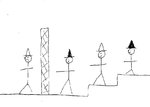Had a go at this, solved it on my second attempt, couldn't be bothered to read your solution firewalker99 since it seemed all over the place. This problem is an exercise in maximising as much information at each step as possible:
Solution to the 12 ball problem:
weight 4 balls against 4 balls: two things happen:
1) they balance, we are now only interested in the 4 remaining balls, goto 2A
2) they do not balance, goto 2B
2A: name remaining balls 1,2,3,4. weight 1 and 2, against 3 and a dummy ball (taken from the 8 that balanced. again 2 things happen. If this balances, we know that ball 4 is the culprit and we weight that against a dummy ball to ascertain whether it is lighter or heavier. If it does not balance goto 3A
2B: number the balls on the right scale 1,2,3,4 and on the left 5,6,7,8. Note which way the scale tilted, without loss of generality assume the right side is heavier (we can reverse the numbering otherwise). We now weight 1,5,6 against 7,2,8. Again 2 things happen. If they don't balance goto 3B, But if they balance we know that balls 3 and 4 are the culprits, so all we do is to balance ball 4 against a dummy ball (ball 1 say) and if it balances we know that ball 4 is lightest, if not then ball 3 will be the lightest (we can also weight 3 against 4)
3A: we not the which side is heavier, assume it is the right side (same treatment for left side). We not balance balls 2 and 3 against 2 dummy balls. 3 things happens. If they balance we know that ball 1 is the lightest ball. If the right side is still heavy we know that ball 2 is the lightest. If the left side is heavy we know that ball 3 is the heaviest.
3B: if the right side is still heavier then we know that balls 1,7,8 are the culprits, if the left side is heavier we know that balls 5,6,2 are the culprits. We now need to deal with 3 balls, so assume that 1,7,8 are the culprits (treaments of 5,6,2 is similar), Weight balls 1,7 against 2 dummy balls. 3 things happen. If they balance we know 8 is the heaviest (since the weighing before the right side was heavier). If the right side is still heavier we know that ball 1 is the lightest. If the left side is heavier we know that ball 7 is the heaviest

